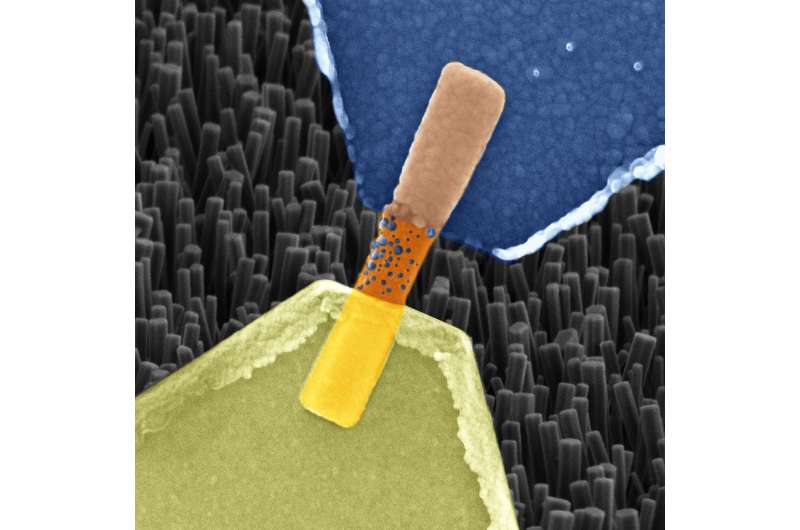Artificial synapses made from nanowires

Scientists from Jülich together with colleagues from Aachen and Turin have produced a memristive element made from nanowires that functions in much the same way as a biological nerve cell. The component is able to save and process information, as well as receive numerous signals in parallel. The resistive switching cell made from oxide crystal nanowires is thus an ideal candidate for use in building bioinspired "neuromorphic" processors, able to take over the diverse functions of biological synapses and neurons.
Computers have learned a lot in recent years. Thanks to rapid progress in artificial intelligence they are now able to drive cars, translate texts, defeat world champions at chess, and much more besides. In doing so, one of the greatest challenges lies in the attempt to artificially reproduce the signal processing in the human brain. In neural networks, data are stored and processed to a high degree in parallel. Traditional computers, on the other hand, rapidly work through tasks in succession and clearly distinguish between the storing and processing of information. As a rule, neural networks can only be simulated in a very cumbersome and inefficient way using conventional hardware.
Systems with neuromorphic chips that imitate the way the human brain works offer significant advantages. These types of computers work in a decentralised way, having at their disposal a multitude of processors, which, like neurons in the brain, are connected to each other by networks. If a processor breaks down, another can take over its function. What is more, just like in the brain, where practice leads to improved signal transfer, a bioinspired processor should have the capacity to learn.
"With today's semiconductor technology, these functions are to some extent already achievable. These systems are, however, suitable for particular applications and require a lot of space and energy," says Dr. Ilia Valov from Forschungszentrum Jülich. "Our nanowire devices made from zinc oxide crystals can inherently process and even store information, and are extremely small and energy efficient."
For years, memristive cells have been ascribed the best chances of taking over the function of neurons and synapses in bioinspired computers. They alter their electrical resistance depending on the intensity and direction of the electric current flowing through them. In contrast to conventional transistors, their last resistance value remains intact even when the electric current is switched off. Memristors are thus fundamentally capable of learning.
In order to create these properties, scientists at Forschungszentrum Jülich and RWTH Aachen University used a single zinc oxide nanowire, produced by their colleagues from the polytechnic university in Turin. Measuring approximately one 10,000th of a millimeter in size, this type of nanowire is over 1,000 times thinner than a human hair. The resulting memristive component not only takes up a tiny amount of space, but is also able to switch much faster than flash memory.
Nanowires offer promising novel physical properties compared to other solids and are used among other things in the development of new types of solar cells, sensors, batteries and computer chips. Their manufacture is comparatively simple. Nanowires result from the evaporation deposition of specified materials onto a suitable substrate, where they practically grow of their own accord.
In order to create a functioning cell, both ends of the nanowire must be attached to suitable metals, in this case platinum and silver. The metals function as electrodes, and in addition, release ions triggered by an appropriate electric current. The metal ions are able to spread over the surface of the wire and build a bridge to alter its conductivity.
Components made from single nanowires are, however, still too isolated to be of practical use in chips. Consequently, the next step being planned by the Jülich and Turin researchers is to produce and study a memristive element, composed of a larger, relatively easy to generate group of several hundred nanowires offering more exciting functionalities.
More information: Gianluca Milano et al, Self-limited single nanowire systems combining all-in-one memristive and neuromorphic functionalities, Nature Communications (2018). DOI: 10.1038/s41467-018-07330-7
Journal information: Nature Communications
Provided by Forschungszentrum Juelich


















